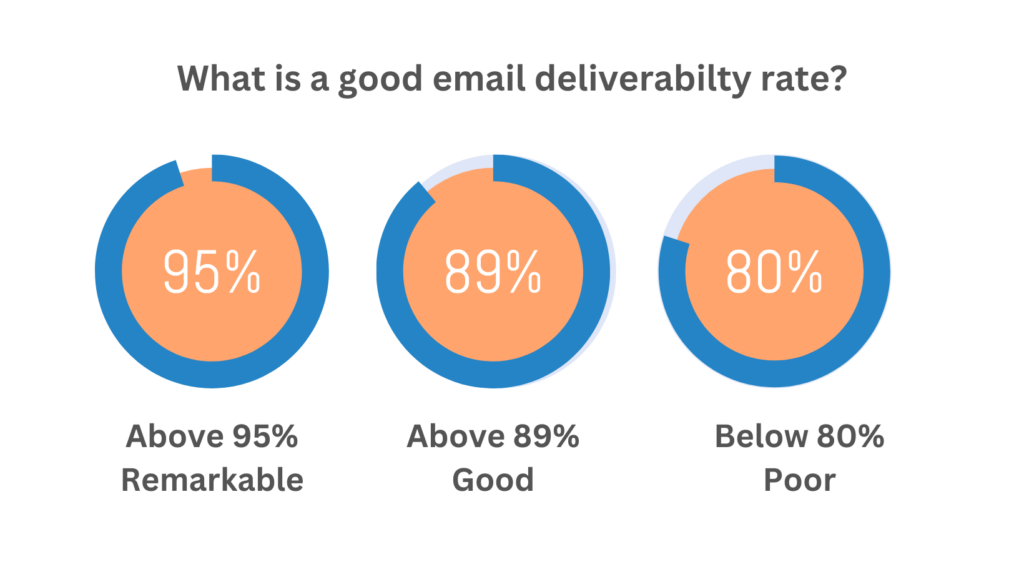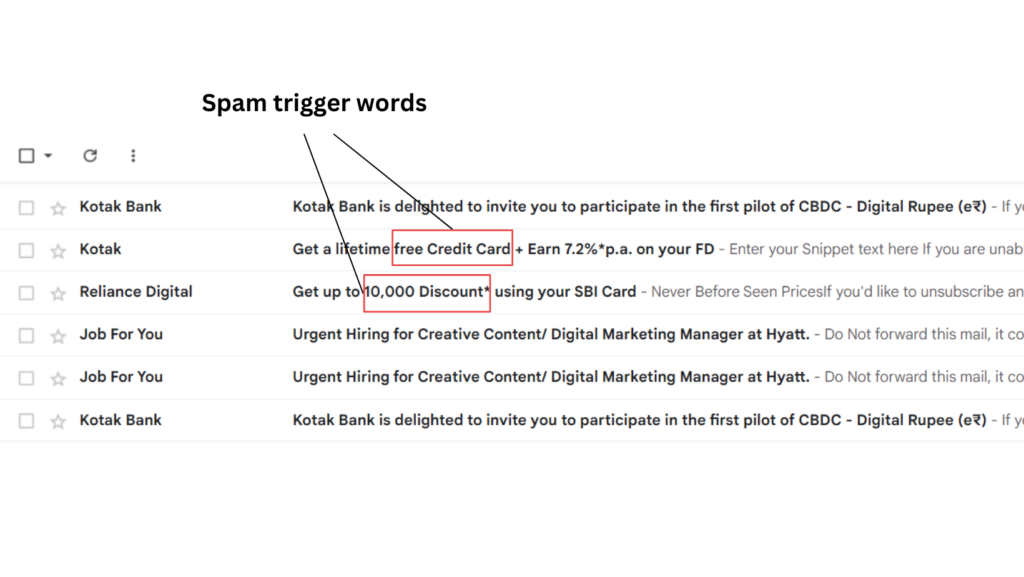Ever wonder if your emails are actually reaching people? That’s where email deliverability comes in. It’s all about making sure your emails end up where they belong—in someone’s inbox, not lost in spam.
But what’s a good deliverability rate? Let’s discover the same in this blog post and also understand the reasons that can affect your email deliverability as well as learn some best practices to improve it.
What is a Good Email Deliverability Rate?
A good email deliverability rate signifies the percentage of emails that successfully land in the recipients’ inboxes, undeterred by spam folders or other delivery issues. Typically, a deliverability rate of 95% or higher is considered excellent.

Reasons that affect your email deliverability rate:
1. High Complaint Rate
When recipients mark your emails as spam or consistently complain about receiving them, it signals to email service providers (ESPs) that your content is unwanted. This negatively impacts your sender’s reputation and subsequently your deliverability rates.
Let’s say you run a newsletter campaign. If subscribers find your content irrelevant or misleading and consistently mark it as spam, it increases your complaint rate. For instance, using deceptive subject lines promising free products but delivering promotional content can lead to increased complaints.
2. Bounce Rate
The bounce rate signifies the percentage of emails that the intended recipient does not receive. Thus, bounces can be classified into two types: soft bounces, which are temporary issues like a full mailbox, and hard bounces, indicative of permanent issues like an invalid email address. Moreover, a high bounce rate indicates potential issues with your email list quality.
If you send emails to a list without proper validation and cleaning, you might encounter a high bounce rate due to invalid or outdated email addresses. This harms your sender’s reputation and, consequently, your deliverability.
3. Spam Traps
Email providers create spam traps to catch spammers, either by maintaining inactive addresses or by recycling addresses from abandoned accounts. When an email lands in these traps, it negatively impacts the sender’s reputation.
If you purchase an email list without proper checking, consequently containing old or recycled email addresses, your sender’s reputation is at risk. Subsequently, if any of these addresses turn out to be spam traps, your deliverability will likely suffer.
4. Low Engagement
Low engagement refers to a lack of interaction with your emails, such as low open rates or minimal click-through rates. Email service providers interpret low engagement as a sign that your content is not relevant to recipients, impacting your sender’s reputation.
To check the average engagement rate as per your industry you can follow the chart from WebEx given below which shows the average open rate, clickthrough rate, unsubscribe rate, and bounce rate.
| INDUSTRY | OPEN RATE | CLICK-THROUGH RATE | UNSUBSCRIBE RATE | BOUNCE RATE |
| Advertising and marketing | 19.30% | 2.60% | 0.20% | 1.10% |
| Agriculture, forestry, fishing, and hunting | 20.50% | 3.50% | 0.2 | 0.5 |
| Automotive and aerospace | 12.60% | 1.20% | 0.20% | 0.80% |
| Beauty and personal care | 16.65% | 1.92% | 0.30% | 0.26% |
| Construction, contracting, manufacturing | 22.40% | 3.20% | 0.30% | 2.20% |
| Consumer packaged goods | 14.50% | 1.60% | 0.10% | 0.40% |
| Ecommerce | 15.68% | 2.01% | 0.27% | 0.19% |
| Education | 23.40% | 3.00% | 0.20% | 1.10% |
| Engineering, architecture, design | 20.40% | 3.00% | 0.20% | 1.10% |
| Financial services | 20.20% | 2.50% | 0.20% | 1.20% |
| Food and beverage | 13.00% | 1.20% | 0.10% | 0.30% |
| Government | 30.50% | 4.10% | 0.20% | 1.30% |
| Health and fitness | 21.48% | 2.69% | 0.40% | 0.30% |
| Healthcare services | 19.70% | 2.70% | 0.20% | 1.00% |
| Insurance | 21.36% | 2.13% | 0.25% | 0.67% |
| IT, tech, software services | 17.60% | 2.50% | 0.20% | 0.90% |
| Legal | 22.00% | 2.81% | 0.22% | 0.52% |
| Logistics and wholesale | 18.90% | 2.20% | 0.30% | 1.20% |
| Media, entertainment, publishing | 18.10% | 3.10% | 0.10% | 0.40% |
| Nonprofit | 25.20% | 2.60% | 0.20% | 1.00% |
| Pharmaceuticals | 18.58% | 2.25% | 0.17% | 0.39% |
| Professional services | 18.00% | 1.80% | 0.20% | 0.80% |
| Real estate, design, construction | 19.90% | 3.60% | 0.20% | 1.40% |
| Restaurants | 19.77% | 1.34% | 0.28% | 0.37% |
| Retail | 13.90% | 2.10% | 0.10% | 0.40% |
| Travel, hospitality, leisure | 15.70% | 1.60% | 0.10% | 0.50% |
If your email content lacks personalization or relevance, recipients might not engage with it. For example, sending generic emails that don’t address the subscriber’s interests or needs might result in low engagement.
5. Unauthenticated Emails
Email authentication involves implementing protocols like SPF, DKIM, and DMARC to verify the legitimacy of your emails. Failure to authenticate emails can result in them being marked as suspicious.
If you haven’t configured SPF, DKIM, or DMARC for your domain, your emails might appear suspicious to recipient servers. For instance, without proper authentication, your email might end up in the spam folder or not even reach the recipient’s inbox.
6. Inconsistency in Sending Patterns
Inconsistent sending patterns, such as irregular email volumes or sudden increases in activity, can trigger spam filters. In order to identify authentic senders, email service providers search for patterns; deviations from these patterns may cause concern.
Suppose you usually send emails once a month, but suddenly, you start sending multiple emails every day for a week. This sudden change in sending behavior might raise red flags with ESPs, potentially impacting your deliverability.
7. Poor Quality Email List
A poor-quality email list, characterized by outdated, purchased, or unsegmented contacts, can have detrimental effects on your email marketing efforts.
By sending emails to such a list, you significantly increase the likelihood of bounces, complaints, and spam traps, which can ultimately harm your sender’s reputation.
Buying email lists from third parties might seem like a quick way to build a subscriber base, but these lists often contain invalid or inactive email addresses. Sending emails to these addresses leads to higher bounce rates and lower engagement.
8. Content Issue
- Spam-triggering Words: Employing words such as “free,” “guarantee,” or “urgent” excessively can trigger spam filters.

- Misleading Subject Lines: It’s crucial that subject lines accurately represent the email content. Moreover,
- Excessive Punctuation: Overuse of punctuation (!!!!) can be flagged as spam. Furthermore,
- Relevance and Value: Ensuring that content is both relevant and valuable to the recipient is essential.
Suppose you send an email with the subject line “Free Gift Inside!” However, the content only promotes products without any mention of a gift. This misleading subject line coupled with the usage of “free” might trigger spam filters or lead recipients to mark your email as spam due to the mismatch in expectations and content delivery.
Best Practices for Good Email Deliverability
Improving email deliverability is crucial for successful email marketing campaigns. Here are 7 Email deliverability best practices to follow- an easy step-by-step guide to boost your email deliverability rate:
1. Use trusted sources & responsible methods to build your email lists: Use ethical methods to grow your email lists, ensuring you have permission from recipients to send emails.
2. Build and cultivate the sender’s reputation: Maintain a positive sender reputation by consistently sending relevant content, avoiding spam complaints, and adhering to best practices.
3. Follow the trust and engagement mantra: Engage with your audience regularly. Encourage interactions, replies, and feedback to establish trust and rapport with subscribers.
4. Create engaging content: Craft compelling, valuable content that resonates with your audience. Personalize where possible, and ensure your content aligns with subscribers’ interests.
5. Choose a solid email marketing platform: Opt for a reputable email marketing service provider that offers strong deliverability rates, robust analytics, and compliance with email regulations.
6. Stay away from Email Bounces: Regularly clean your email list to eliminate invalid or inactive addresses. Monitor and manage bounce rates to maintain a healthy list.
7. Use branding in your “from” name: Incorporate your brand name or a recognizable sender name in the “From” field to increase recognition and trust among recipients.
Conclusion
Email deliverability isn’t just a metric; it’s a lifeline for your marketing efforts. Striving for a high deliverability rate isn’t merely about getting into inboxes—it’s about fostering genuine engagement and trust with your audience.
By considering cold email automation tool like SafeMailer you will able to maintain a good email deliverability rate and boost your email.

Leave a Reply